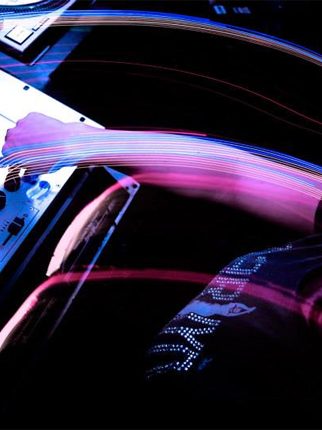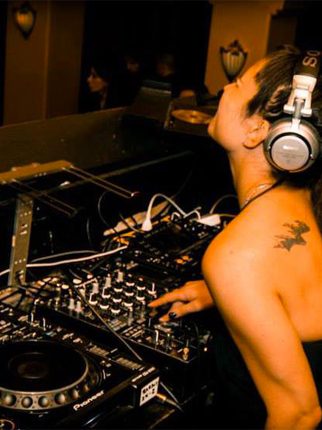So You Wanna Be a DJ #4: Sounds
Welcome to the ongoing series So You Wanna Be a DJ by Charissa Saverio (aka DJ Rap). If you’re joining us for the first time, you can read previous articles in the series here.
As we discussed in part three, it’s important to choose the right sounds and keep them simple. Now, let’s get more into how to make those sounds come alive.
Let’s talk about kicks. The first thing you hear in life is your mother’s heartbeat, so you are already used to four-to-the-floor rhythm. Making them really break through your mix is key. Kicks are what make your fans move to the groove, so it’s no small task selecting a kick sound and processing it properly.
First, choose the sound. There are tons of libraries full of kicks and one-hits and samples out there, and while some are better than others, you can generally shape a great kick out of a mediocre sample with a little massaging. Again, it’s important here to listen to your idols. Different types of kicks work for different styles of dance music. Electro goes great with a real knocky, heady kick; trance is great over a pulsing, urgent kick; and progressive minimal house (my latest affair) can really take off with a deep, crisp kick that slices through the mix.
Say we’re just looking for your classic four-on-the-floor propa house kick. This sound should be understated and clean while carrying enough weight to support the rest of your mix. It’s okay to end up changing your kick halfway through producing the track if you find that, once you start threading layers through your tune, the kick’s gone pear-shaped. I do it all the time.
Whoo… Enough on the ideology of the kick drum! Let’s get technical.
Once you’ve chosen your sound, you want to identify what needs to happen to the kick to get it throbbing. When starting out producing your own music, it’s always a good idea to find a track that has the sound you’re going for and put it into your sequencer right up against your track. That’s called “reference mixing,” and I can’t stress enough how invaluable it is. The two basic tools you’re most likely going to use on your kick are a compressor and an EQ. I EQ first, so let’s start with that.
If you’re using a real sampled bass drum, like from a drum set, I almost always notch out 300 Hz by at least five dB. Real kick drums just have a “boxiness” to them in that range that tends to kill a mix. The best way to find out which frequencies are helping your sound and which ones are ugly is to boost one band of your EQ about six to nine dB. Sweep through the frequencies top to bottom, noting the areas that are warm and sweet, and which areas are harsh or unnecessary.
Any time you’re changing a sound, keep in mind: Add with EQ to change a sound, and cut with EQ to improve a sound (says Confucius.) As always, this is all just a means to an end, so if you find that cutting 600 Hz by 24 dB gets you what you want, then by all means, cut 600 Hz by 24 dB. If it sounds good, it is good. Beware, though: If you’re using cheap computer speakers, it might sound like you need to boost the low end of the kick by 15 dB or more, until you hear the bass. If you play this at a club, it could blow the subs, which makes for very unhappy promoters and even madder club owners. That’s where reference mixes can save your life.
Compression! Oooh, compression. This can be a love/hate kind of relationship. Keep in mind that kick samples might already be compressed to your liking, which is great and might mean you don’t have to get into this at all. But if you’re a perfectionist like me, you’ll usually do the compressing yourself. Now, compression is going to give your kick the width and the balls you’ll need to knock over a dancefloor, and there are different theories on the best way to accomplish this. Let’s just start with setting your compressor.
General rule of thumb: Load up a compressor, and turn the attack to the highest/longest setting and the release to the lowest/shortest. Now, here’s where there are different schools of thought. I like to squash the shit out of it at this point to make it very clear where the attack and release should be. So, I’ll set the threshold pretty low and the ratio high—somewhere around 6:1. Now, bring your attack down/shorter slowly, until you hear the kick lose its vigor, and turn it back just a bit. And with the release, move that longer and longer, until you hear it pump from one beat to the next. You want the next kick to fire right when the release from your first kick is finished. This will give you that classic pumping house kick that’s oh-so-tasty. Lastly, readjust your threshold and ratio to settings that please you and complement the mix. There are no set rules here, so go ahead and follow your ears.
I’m going to leave you with that for this installment. I hope you can use some of this knowledge to shape your kicks like the pros and really kill the crowds.
Luv and bass…
After designing curricula for schools like Icon Collective, then teaching at Dubspot, DJ Rap launched her very own school, Music Tech Collective, on October 12.
Follow DJ Rap on Facebook | Twitter | SoundCloud





